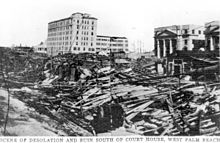History of West Palm Beach, Florida
By the 1870s and 1880s, non-Native American settlers had inhabited areas in the vicinity of West Palm Beach and referred to the settlement as "Lake Worth Country".
However, the 1928 hurricane – which devastated the city – and end of the land boom ushered the area into an era of economic decline just prior to the onset of the Great Depression.
West Palm Beach experienced an economic rebound in the post-World War II years, as veterans who trained at Morrison Field vacationed or relocated to the area.
[8] Reverend Elbridge Gale and his son are believed to have constructed the first log cabin on the western shore of Lake Worth, located near where the intersection of 29th Street and Poinsettia Avenue stands today.
That year, Flagler began planning a city to house the employees working in the two grand hotels on the neighboring island of Palm Beach.
[6] The east-to-west oriented streets were named alphabetically from north to south – Althea, Banyan, Clematis, Datura, Evernia, Fern – while some of the north-to-south roads were called Lantana, Narcissus, Olive, Poinsettia, Rosemary, and Tamarind.
Voters elected John S. Earman as the first mayor, while Henry J. Burkhardt, E. H. Dimick, J. M. Garland, H. T. Grant, J. F. Lamond, and George Zapf became the town's first aldermen.
[15] Although Flagler intended for the West Palm Beach area to be the southern terminus of his railroad, the track was extended farther southward to Miami after two severe freezes in the winter of 1894–95.
[23] By the turn of the century, West Palm Beach had electrical and telephone service, a library, a sewer system, a pumping station, and paved roads.
[7] Banyan Street, originally the only location where alcohol was sold, gained an infamous reputation for its brothels, gambling halls, and saloons, which included an incident in 1895 in which Mayor Earman was arrested and charged with public intoxication while accompanying a prostitute.
Prior to the 1910s, many African Americans in the area lived in a segregated section of Palm Beach called the "Styx",[7] with an estimated population of 2,000 at its peak.
[27] Most of the displaced residents relocated to the northern end of West Palm Beach, in neighborhoods today known as Northwest, Pleasant City, and Freshwater.
[30] As of November 2017, The Palm Beach Post ranked as the fifth largest newspaper by circulation in the state of Florida, behind only the Miami Herald, Sun-Sentinel, Orlando Sentinel, and Tampa Bay Times.
[7] All areas of West Palm Beach east of Australian Avenue had been platted by 1927, although sections north of 36th Street and south of Southern Boulevard remained mostly undeveloped.
[52] At Flamingo Park, one of the worst hit areas of the city, many homes suffered damage, while a shopping center on Lake Avenue experienced near complete destruction.
The remaining 674 bodies who were black or of an unidentifiable race were mass buried at a site near the junction of 25th Street and Tamarind Avenue, which was the city's paupers cemetery.
At the pauper's cemetery, a funeral service was hosted by several local clergymen and attended by about 3,000 people, including educator Mary McLeod Bethune.
Initially, the college's goal was to provide additional training to local high school graduates who were unable to find jobs during the Great Depression.
[61] After learning to fly an airplane in 1932, Grace Morrison began an effort to gain support for a public airport in Palm Beach County.
The 313th Material Squadron was moved from Miami Municipal Airport to Morrison Field in April 1942, with approximately 1,000 men working around the clock in order to repair and test aircraft before they were put into service.
In order to transform the wetlands into dry land, Perini hired Gee and Jensen Engineers, who used approximately 30,000,000 cubic yards (23,000,000 m3) of fill to complete the task.
The opening ceremony included a ribbon-cutting by Governor Claude Kirk, Mayor Reid Moore Jr., and Miss USA 1967 winner Cheryl Patton.
Then-United States Senator Lawton Chiles referred to the area as a "war zone" during his visit in September 1987, while local politicians were not optimistic about the future of downtown.
Candidates included attorney and former state representative Joel T. Daves III, city senior planner Jim Exline, Nancy M. Graham,[91] Josephine Stenson Grund,[92] property management company owner Michael D. Hyman, and former Palm Beach County commissioner Bill Medlen.
[95] Architect Dan Kiley was hired for several of the waterfront projects, including building an amphitheater, remodeling the library, and designing an interactive water fountain at Flagler Park.
[100] The $375 million project called for an 18 to 24 screen movie theater and a number of restaurants, upscale stores, apartments, and office buildings,[101] all centered around the historical First United Methodist Church,[100] which later became the Harriet Himmel Theatre.
[1] With the number being just 81 short of 100,000, then-outgoing mayor Lois Frankel indicated the potential for challenging the tally, as having a population of at least 100,000 would entitle the city to additional grants.
After a significant decline in foot traffic and tenants,[120] as well as failed attempts to lure big box stores such as Bass Pro and IKEA to the mall,[121] it was demolished in 2013.
[123] With the closure of the municipal stadium in 1997 (and its subsequent demolition in 2002), West Palm Beach had lost its ability to host spring training for a Major League Baseball.
A suspect, later identified as 58-year-old Ryan Wesley Routh, was spotted hiding in nearby shrubbery while aiming a rifle at a member of Trump's security detail.


















